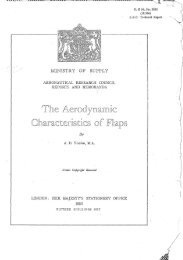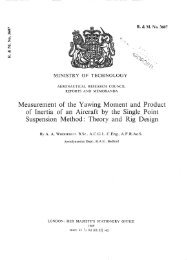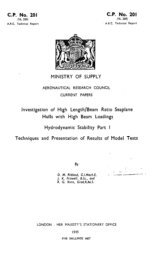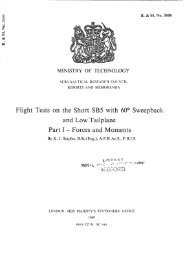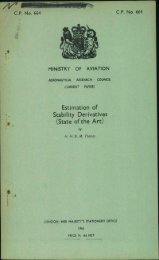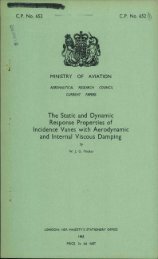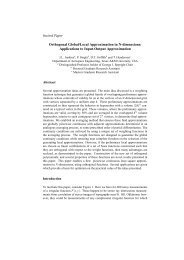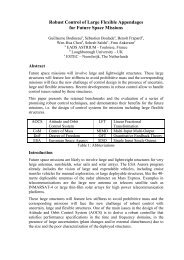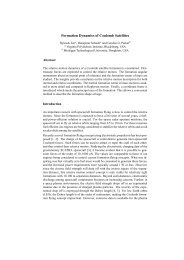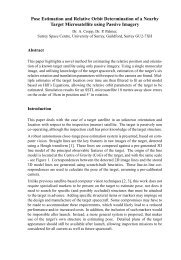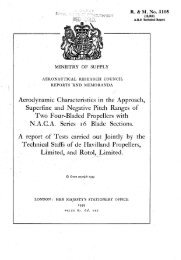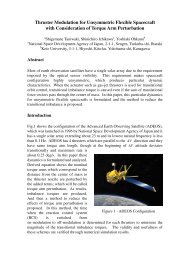The Prediction of Helicopter Rotor Hover Performance using a ...
The Prediction of Helicopter Rotor Hover Performance using a ...
The Prediction of Helicopter Rotor Hover Performance using a ...
You also want an ePaper? Increase the reach of your titles
YUMPU automatically turns print PDFs into web optimized ePapers that Google loves.
velocity and hence to the momentum through the disc. This <strong>of</strong> course leads to<br />
changes in the predicted power and the shape <strong>of</strong> the radial load distribution.<br />
Introducing the wake induced velocity as a perturbation to the momentum downwash<br />
and ensuring that the thrust on each element <strong>of</strong> the blade <strong>using</strong> strip element<br />
theory is consistent with momentum theory appears to reduce the sensitivity to<br />
tip vortex location considerably and to keep changes in the radial load distri<br />
bution to a minimum.<br />
<strong>The</strong> variation <strong>of</strong> rotor performance with changes in the rotor geometry is<br />
to be expected as both model and full scale tests generally show a scatter in<br />
the power required to produce a given thrust, but the observed variation is<br />
much smaller than that predicted <strong>using</strong> the wake induced velocities. <strong>The</strong> wake in<br />
its standard position, as used throughout section 3, would be expected to give a<br />
reasonable approximation to the mean performance <strong>of</strong> the rotor, whereas in all<br />
the cases considered, the rotor power was overestimated and the tip vortex has<br />
had to be moved further away from the blade. This suggests that the representa<br />
tion <strong>of</strong> the wake, and in particular, the tip vortex by a series <strong>of</strong> trailing line<br />
vortex elements is inadequate. Cook has investigated the structure <strong>of</strong> the tip<br />
vortex from a rotor blade <strong>using</strong> a hot wire anemometer and has shown that the<br />
effective size <strong>of</strong> the vortex core was larger than simple theory suggested<br />
although the vortex core was significantly smaller. <strong>The</strong> velocity field induced<br />
by the tip vortex was also considerably different from that represented by a<br />
vortex with uniform vorticity in the core. <strong>The</strong> mathematical representation <strong>of</strong><br />
the tip vortex, and possibly the rest <strong>of</strong> the wake would seem to be oversimplified<br />
and this may be the reason why some <strong>of</strong> the 'free wake' methods as well as the<br />
prescribed wake methods fail to achieve the expected results. <strong>The</strong> wake momentum<br />
theory appears to overcome these problems by its treatment <strong>of</strong> the wake velocity<br />
as an interference velocity and leads to a more reliable calculation.<br />
5 CONCLUSIONS<br />
A method <strong>of</strong> predicting the performance <strong>of</strong> a helicopter rotor in the hover<br />
has been developed. <strong>The</strong> calculation combines strip element-momenturn theory with<br />
the inflow distribution induced by a contracting vortex wake. <strong>The</strong> wake takes a<br />
prescribed geometry developed from a comprehensive series <strong>of</strong> model tests made<br />
in the USA.<br />
<strong>The</strong> theory has been compared with measurements made on model and full<br />
scale rotors and has always predicted the rotor thrust and power accurately<br />
25



